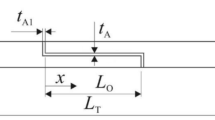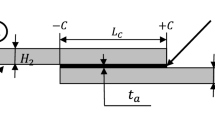Abstract
Nowadays, adhesive bonding is an essential joining technique in top-end sectors, such as aircraft, automotive, and construction industries. Due to their advantages over traditional joining methods, adhesive joints research has been under huge developments in recent years, being the development of accurate and efficient numerical techniques a leading challenge in adhesive joint design. Although the finite element method (FEM) is an established discretisation technique, meshless methods emerged as alternative discretisation methods to evaluate adhesive joints. Nonetheless, meshless techniques still require deeper research in adhesive joint simulations, where strength prediction is hindered by intricate stress states and material behaviour. This paper aims to evaluate the natural neighbours radial point interpolation method (NNRPIM) in the linear analysis of adhesive joints. The capability of the method was addressed by comparing it with analytical models, the FEM and experimental data. As the applications of meshless methods to analyse adhesive joints are scarce, this work evaluates the behaviour of double-lap joints (DLJ) considering distinct overlap lengths and adhesive materials. DLJ has a different behaviour than single-lap joints, which are more commonly analysed. Thus, this work provides a preliminary linear analysis, which could be the basis for further analyses of adhesive joints combining the NNRPIM with elastic–plastic, hyper-elastic, and large deformations formulations. Although it is remarked that elastic formulations underpredict joint strength, the NNRPIM shows similar results to the FEM, which supports the extension of the NNRPIM to more representative mathematical formulations and complex joint designs.















Similar content being viewed by others
References
Adams RD, Wake WD (1984) Structural adhesive joints in engineering. Elsevier Applied Science Publishers LTD, Essex, England
Her S-C, Chan C-F (2019) Interfacial stress analysis of adhesively bonded lap joint. Materials (Basel) 12(15):2403. https://doi.org/10.3390/ma12152403
Silva LFM, Dillard DA, Blackman B, Adams RD (2012) Testing adhesive joints. Wiley, Hoboken
Banea MD, da Silva LFM, Campilho RDSG (2015) The effect of adhesive thickness on the mechanical behavior of a structural polyurethane adhesive. J Adhes 91(5):331–346. https://doi.org/10.1080/00218464.2014.903802
Saraç İ, Adin H, Temiz Ş (2019) Investigation of the effect of use of Nano-Al2O3, Nano-TiO2 and Nano-SiO2 powders on strength of single lap joints bonded with epoxy adhesive. Compos Part B Eng 166:472–482. https://doi.org/10.1016/J.COMPOSITESB.2019.02.007
Adin MŞ, Kiliçkap E (2021) Strength of double-reinforced adhesive joints. Mater Test 63(2):176–181. https://doi.org/10.1515/MT-2020-0024
Nunes SLS et al (2016) Comparative failure assessment of single and double lap joints with varying adhesive systems. J Adhes 92:610–634. https://doi.org/10.1080/00218464.2015.1103227
da Silva LFM, das Neves PJC, Adams RD, Spelt JK (2009) Analytical models of adhesively bonded joints—Part I: literature survey. Int J Adhes Adhes;29(3):319–330. https://doi.org/10.1016/j.ijadhadh.2008.06.005.
da Silva LFM, das Neves PJC, Adams RD, Wang A, Spelt JK (2009) Analytical models of adhesively bonded joints-Part II: comparative study.In. J Adhes Adhes;29(3):331–341. https://doi.org/10.1016/j.ijadhadh.2008.06.007
Crocombe A, Kinloch A (1994) Review of adhesive bond failure criteria. AEA technol., no. 1
Hart-Smith LJ (1973) Adhesive-bonded single-lap joints. Hampton, Virginia
Sadeghi MZ et al (2020) Failure load prediction of adhesively bonded single lap joints by using various FEM techniques. Int J Adhes Adhes 97:102493. https://doi.org/10.1016/j.ijadhadh.2019.102493
Liu GR (2016) An overview on meshfree methods: for computational solid mechanics. Int J Comput Methods 13(5):1630001. https://doi.org/10.1142/S0219876216300014
Chen JS, Hillman M, Chi SW (2017) Meshfree methods: progress made after 20 years. J Eng Mech. https://doi.org/10.1061/(ASCE)EM.1943-7889.0001176
Wang JG, Liu GR (2002) A point interpolation meshless method based on radial basis functions. Int J Numer Methods Eng 54(11):1623–1648. https://doi.org/10.1002/nme.489
Belinha J (2014) Meshless methods in biomechanics - bone tissue remodelling analysis, 1st edn. Springer, Cham
Belinha J, Araújo AL, Ferreira AJM, Dinis LMJS, NatalJorge RM (2016) The analysis of laminated plates using distinct advanced discretization meshless techniques. Compos Struct 143:165–179. https://doi.org/10.1016/j.compstruct.2016.02.021
Ramalho LDC, Campilho RDSG, Belinha J, Silva LFM (2020) Static strength prediction of adhesive joints: a review. Int J Adhes Adhes 96. https://doi.org/10.1016/j.ijadhadh.2019.102451
Tsai CL, Guan YL, Ohanehi DC, Dillard JG, Dillard DA, Batra RC (2014) Analysis of cohesive failure in adhesively bonded joints with the SSPH meshless method. Int J Adhes Adhes 51:67–80. https://doi.org/10.1016/j.ijadhadh.2014.02.009
Mubashar A, Ashcroft IA (2017) Comparison of cohesive zone elements and smoothed particle hydrodynamics for failure prediction of single lap adhesive joints. J Adhes 93(6):444–460. https://doi.org/10.1080/00218464.2015.1081819
Ramalho LDC, Campilho RDSG, Belinha J (2020) Single lap joint strength prediction using the radial point interpolation method and the critical longitudinal strain criterion. Eng Anal Bound Elem 113:268–276. https://doi.org/10.1016/j.enganabound.2020.01.010
Markolefas SI, Papathanassiou TK (2009) Stress redistributions in adhesively bonded double-lap joints, with elastic-perfectly plastic adhesive behavior, subjected to axial lap-shear cyclic loading. Int J Adhes Adhes 29(7):737–744. https://doi.org/10.1016/j.ijadhadh.2009.04.001
De Sousa CCRG, Campilho R, Marques EAS, Costa M, Da Silva LFM (2017) Overview of different strength prediction techniques for single-lap bonded joints. Proc Inst Mech Eng Part L J Mater Des Appl;231(1–2):210–223. https://doi.org/10.1177/1464420716675746.
ASTM-E8M-04 (2004) Standard test methods for tension testing of metallic materials
Zheng R, Lin J, Wang PC, Wu Y (2016) Correlation between surface characteristics and static strength of adhesive-bonded magnesium AZ31B. Int J Adv Manuf Technol 84(5–8):1661–1670. https://doi.org/10.1007/s00170-015-7788-5
Wang S, Liang W, Duan L, Li G, Cui J (2020) Effects of loading rates on mechanical property and failure behavior of single-lap adhesive joints with carbon fiber reinforced plastics and aluminum alloys. Int J Adv Manuf Technol 106(5–6):2569–2581. https://doi.org/10.1007/s00170-019-04804-w
Crocombe AD (1989) Global yielding as a failure criterion for bonded joints. Int J Adhes Adhes 9(3):145–153. https://doi.org/10.1016/0143-7496(89)90110-3
Hart-Smith LJ (1973) Adhesive-bonded double-lap joints. Hampton, Virginia
Rodríguez RQ, de Paiva WP, Sollero P, Rodrigues MRB, de Albuquerque ÉL (2012) Failure criteria for adhesively bonded joints. Int J Adhes Adhes 37:26–36. https://doi.org/10.1016/j.ijadhadh.2012.01.009
Volkersen O (1938) Luftfahrtforschung;15:41–47
Hardy RL (1990) Theory and applications of the multiquadric-biharmonic method. Comput Math with Appl 19(8–9):163–208. https://doi.org/10.1016/0898-1221(90)90272-L
Wang JG, Liu GR (2002) On the optimal shape parameters of radial basis functions used for 2-D meshless methods. Comput Methods Appl Mech Eng 191(23–24):2611–2630. https://doi.org/10.1016/S0045-7825(01)00419-4
Golberg MA, Chen CS, Bowman H (1999) Some recent results and proposals for the use of radial basis functions in the BEM. Eng Anal Bound Elem 23(4):285–296. https://doi.org/10.1016/s0955-7997(98)00087-3
Ramalho LDC, Campilho RDSG, Belinha J (2019) Predicting single-lap joint strength using the natural neighbour radial point interpolation method. J Braz Soc Mech Sci Eng 41(9):1–11. https://doi.org/10.1007/s40430-019-1862-0
Cui J, Wang S, Wang S, Chen S, Li G (2020) Strength and failure analysis of adhesive single-lap joints under shear loading: effects of surface morphologies and overlap zone parameters. J Manuf Process 56:238–247. https://doi.org/10.1016/j.jmapro.2020.04.042
Goglio L, Rossetto M, Dragoni E (2008) Design of adhesive joints based on peak elastic stresses. Int J Adhes Adhes 28:427–435
Chowdhury NM, Chiu WK, Wang J, Chang P (2016) Experimental and finite element studies of bolted, bonded and hybrid step lap joints of thick carbon fibre/epoxy panels used in aircraft structures. Compos Part B Eng 100:68–77. https://doi.org/10.1016/j.compositesb.2016.06.061
Acknowledgements
This work has been funded by the Ministério da Ciência, Tecnologia e Ensino Superior through the Fundação para a Ciência e a Tecnologia (from Portugal), under project fundings ‘MIT-EXPL/ISF/0084/2017’, ‘POCI-01-0145-FEDER-028351’, and ‘SFRH/BD/147628/2019’. Additionally, the authors acknowledge the funding provided by the Associated Laboratory for Energy, Transports and Aeronautics (LAETA), under project ‘UIDB/50022/2020’.
Author information
Authors and Affiliations
Corresponding author
Additional information
Technical Editor: João Marciano Laredo dos Reis.
Publisher's Note
Springer Nature remains neutral with regard to jurisdictional claims in published maps and institutional affiliations.
Rights and permissions
About this article
Cite this article
Gonçalves, D.C., Sánchez-Arce, I.J., Ramalho, L.D.C. et al. Introductory application of a natural neighbour meshless elastic formulation to double-lap adhesive joints. J Braz. Soc. Mech. Sci. Eng. 44, 55 (2022). https://doi.org/10.1007/s40430-021-03355-0
Received:
Accepted:
Published:
DOI: https://doi.org/10.1007/s40430-021-03355-0




